Questions with Answers, Solution | Numbers | Chapter 1 | 8th Maths - Exercise 1.5 (Cubes and Cube Roots) | 8th Maths : Chapter 1 : Numbers
Chapter: 8th Maths : Chapter 1 : Numbers
Exercise 1.5 (Cubes and Cube Roots)
Exercise 1.5
1. Fill in the blanks:
(i) The ones digits in the cube of 73 is____________.
(ii) The maximum number of digits in the cube of a two digit number is ____________.
(iii) The smallest number to be added to 3333 to make it a perfect cube is ___________.
(iv) The cube root of 540×50 is ___________.
(v) The cube root of 0.000004913 is ___________.
2. Say True or False:
(i) The cube of 24 ends with the digit 4.
(ii) Subtracting 103 from 1729 gives 93.
(iii) The cube of 0.0012 is 0.000001728.
(iv) 79570 is not a perfect cube.
(v) The cube root of 250047 is 63.
3. Show that 1944 is not a perfect cube.
Solution:
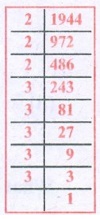
1994 = 2 × 2 × 2 × 3 × 3 × 3 × 3 × 3
= 2 × 2 × 2 × 3 × 3 × 3 × 3 × 3
= 23 × 33 × 3 × 3
There are two triplets to make further triplets we need one more 3.
∴ 1944 is not a perfect cube.
4. Find the smallest number by which 10985 should be divided so that the quotient is a perfect cube.
Solution:
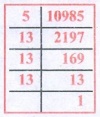
We have 10985 = 5 × 13 × 13 × 13
= 5 × 13 × 13 × 13
Here we have a triplet of 13 and we are left over with 5.
If we divide 10985 by 5. the new number will be a perfect cube.
∴ The required number is 5.
5. Find the smallest number by which 200 should be multiplied to make it a perfect cube.
Solution:
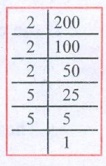
We find 200 = 2 × 2 × 2 × 5 × 5
Grouping the prime factors of 200 as triplets, we are left with 5 × 5
We need one more 5 to make it a perfect cube.
So to make 200 a perfect cube multiply both sides by 5.
200 × 5 = (2 × 2 × 2 × 5 × 5) × 5
1000 = 2 × 2 × 2 × 5 × 5 × 5
Now 1000 is a perfect cube.
∴ The required number is 5.
6. Find the cube root of 24 × 36 × 80 × 25.
Solution:
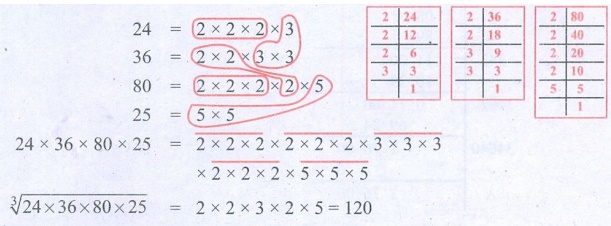
7. Find the cube root of 729 and 6859 by prime factorisation.
Solution:
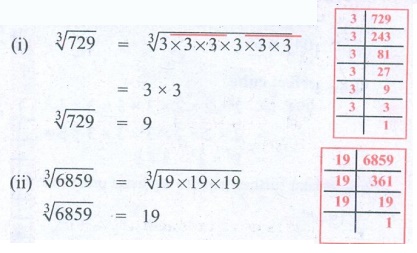
8. What is the square root of cube root of 46656?
Solution:

9. If the cube of a squared number is 729, find the square root of that number.
Solution:
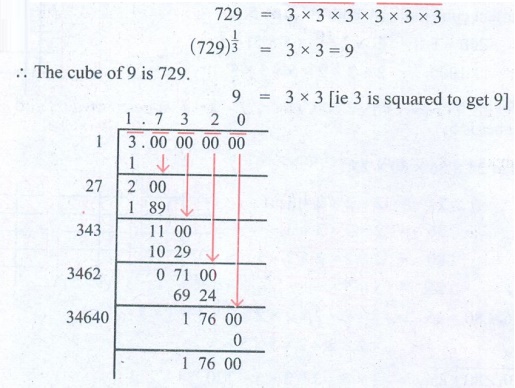
We have to find out √3 , √3 = 1.732
10. Find the two smallest perfect square numbers which when multiplied together gives a perfect cube number.
Solution:
Consider the numbers 22 and 42
The numbers are 4 and 16.
Their product 4 × 16 = 64
64 = 4 × 4 × 4
∴ The required square numbers are 4 and 16
Activity
Observe that
23−13=1+2×1×3
33−23=1+3×2×3
43−33=1+4×3×3
Find the value of 153 −143 in the above pattern.
Observe that
13=1=1
23=8=3+5
33=27=7+9+11
Continue this pattern to find the value of 73 as the sum of consecutive odd numbers
Answer:
Exercise 1.5
1. (i) 7 (ii) 6 (iii) 42
(iv) 30 (v) 0.017
2. (i) True (ii) True (iii)
False (iv) True (v) True
4. 5
5. 5
6. 120
7. 9,19
8. √36 = 6
9. √3 = 1.732
10. 4,16
Related Topics